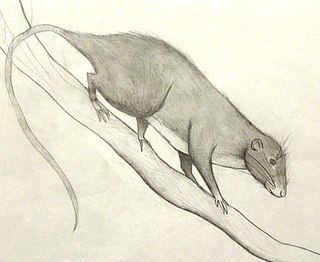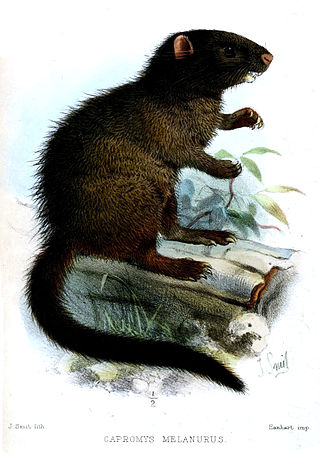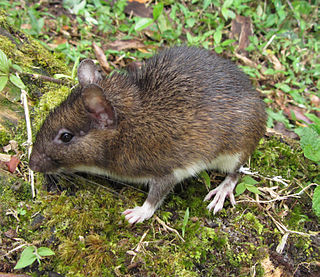
Geocapromys is a genus of rodent belonging to the hutia subfamily and are currently only found on the Bahamas and Jamaica. However, they formerly ranged throughout the Caribbean, from Cuba to the Cayman Islands to even islands off mainland Central America.
Owl's spiny rat is a rodent species in the family Echimyidae found in Brazil. It is the only species in the genus Carterodon. Owl's spiny rat has evolved characteristics such as a heightened ability to dig in open grasslands during times of environmental change.
The giant tree-rat is a species in the family Echimyidae, the spiny rats. It is the only species in the monotypic genus Toromys. It is endemic to Brazil, where it occurs in the flooded forest along the banks of the Amazon River and its tributaries.
The tuft-tailed spiny tree rat is a spiny rat species from Brazil south of the Amazon River, where it has been found in grassland and gallery forest. It is the only species in the genus Lonchothrix. Very little is known about this rodent. It is small with an average adult weight of about 138 grams. It is nocturnal and solitary in habits.
Phyllomys is a genus of arboreal spiny rat, geographically restricted to the forests of eastern Brazil.

Mesomys is a genus of South American spiny rats in the family Echimyidae.

Dactylomys is the genus of South American bamboo rats They are arboreal members of the family Echimyidae.

Olallamys is a genus of Andean soft-furred spiny rat that range from Panama through Colombia and Venezuela to northern Ecuador. These species are typically found at elevations above 2,000 metres (6,600 ft).

Euryzygomatomys is a genus of South American rodents, commonly called guiaras, in the family Echimyidae. It contains two extant and one fossil species, found in Argentina, Brazil and Paraguay. They are as follows:

Diplomys is a genus of rodent in the family Echimyidae. They are found in Costa Rica, Ecuador, Colombia and Panama.
Makalata is a genus of rodents in the family Echimyidae.

Mesocapromys is a genus of rodent in the subfamily Capromyinae. The genus is restricted to Cuba and associated islands.

Plagiodontia is a genus of rodent in the subfamily Capromyinae (hutias). All known species are endemic to the Caribbean island of Hispaniola.
Pattonomys is a genus of rodent in the family Echimyidae, named after American mammalogist James L. Patton. It contains the following species:
Clyomys is a South American rodent genus in the family Echimyidae. It contains two species, found in tropical savannas and grasslands from circa 100 m (300 ft) to 1,100 m (3,600 ft) elevation in central Brazil and eastern Paraguay.

Thrichomys is a genus of South American rodents in the family Echimyidae. It contains at least five species, found in Bolivia, Brazil and Paraguay. They are as follows:

Echimyidae is the family of neotropical spiny rats and their fossil relatives. This is the most species-rich family of hystricognath rodents. It is probably also the most ecologically diverse, with members ranging from fully arboreal to terrestrial to fossorial to semiaquatic habits. They presently exist mainly in South America; three members of the family also range into Central America, and the hutias are found in the West Indies in the Caribbean. Species of the extinct subfamily Heteropsomyinae formerly lived on Cuba, Hispaniola, and Puerto Rico in the Antilles.

Myocastorini is a tribe of echimyid rodents, proposed in 2017, and containing the five extant genera Callistomys, Hoplomys, Myocastor, Proechimys, and Thrichomys.

Euryzygomatinae is a subfamily of rodents, proposed in 2017, and containing three extant genera of spiny Echimyidae: Clyomys, Euryzygomatomys, and Trinomys.

Echimyini is a tribe of echimyid rodents, proposed in 2016, and containing 13 extant genera: all of the tree rats Echimys, Phyllomys, Makalata, Pattonomys, Toromys, Diplomys, Santamartamys, and Isothrix, the long recognized dactylomines Dactylomys, Olallamys, and Kannabateomys, and the enigmatic and previously classified as eumysopines Lonchothrix and Mesomys. All these spiny rats genera are arboreal. Worth of note, the arboreal genus Callistomys – the painted-tree rat – does not belong to the tribe Echimyini. Because it is phylogenetically closer to Myocastor, Hoplomys, Proechimys, and Thrichomys than to the above-mentioned Echimyini genera, it is classified in the tribe Myocastorini.












